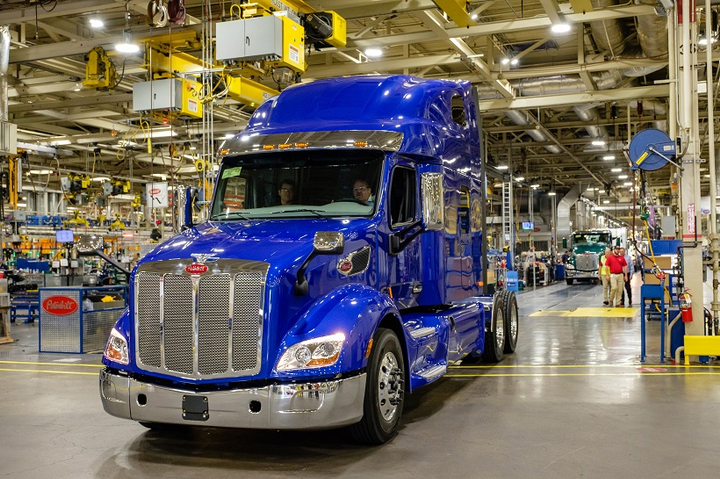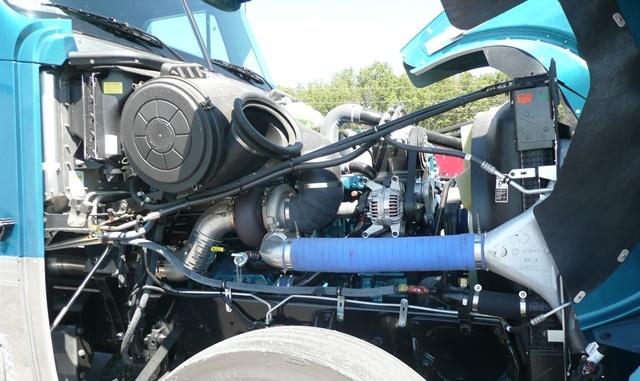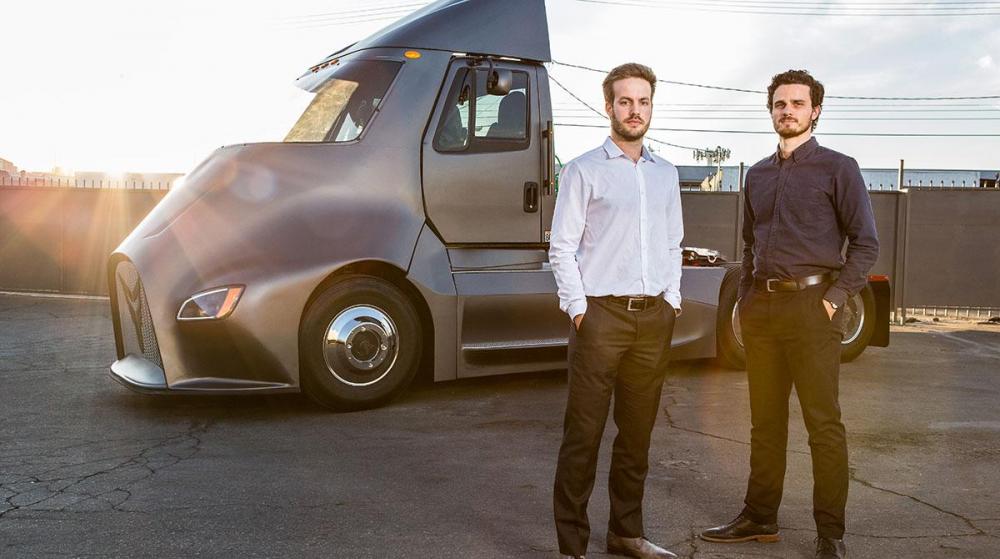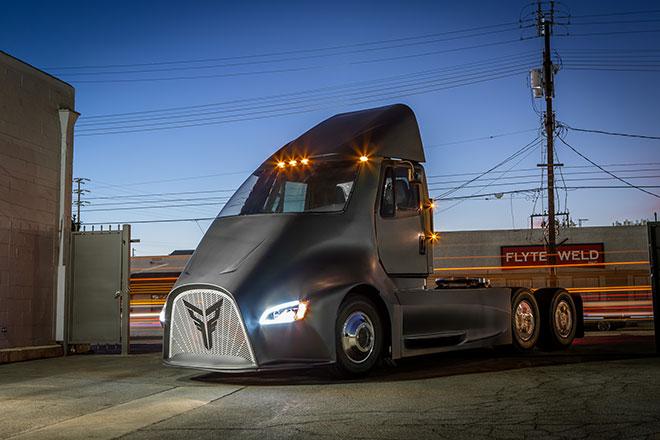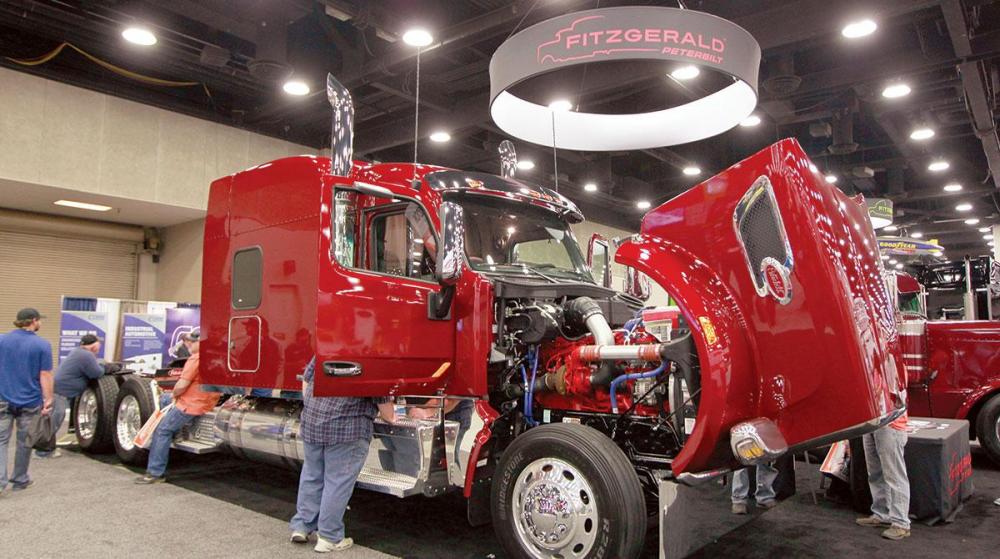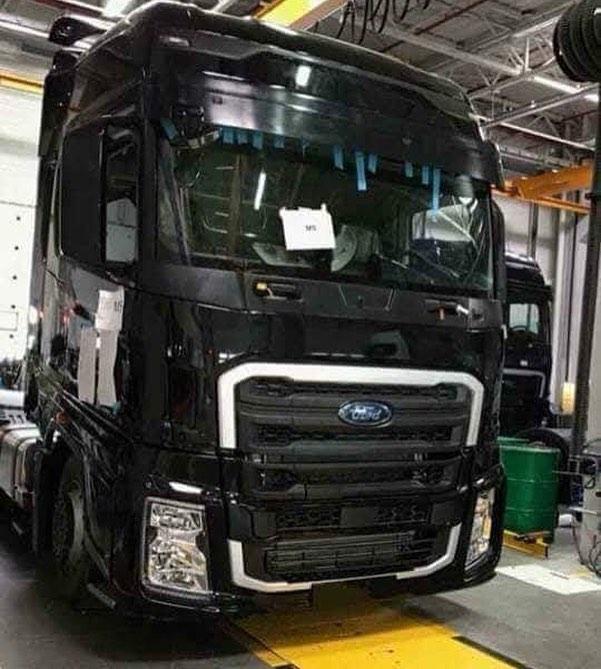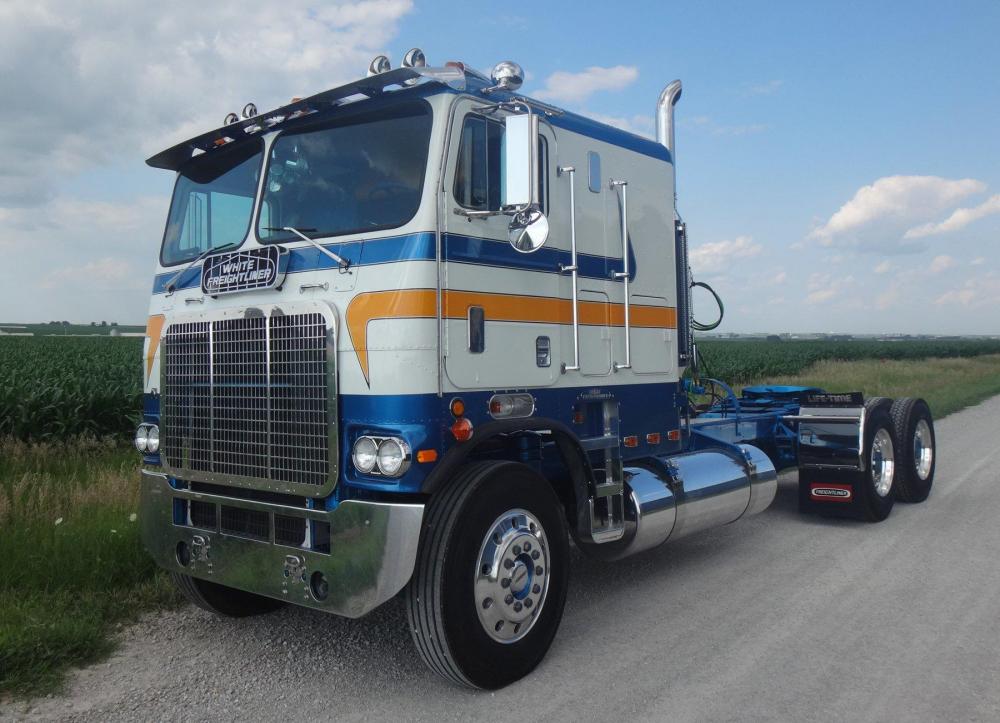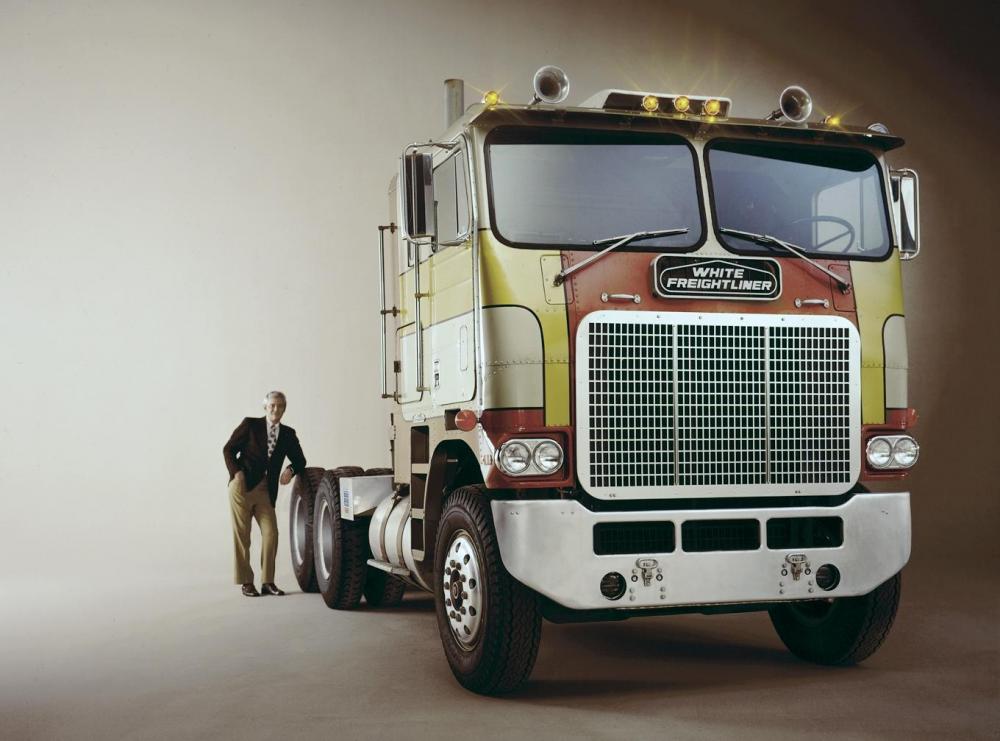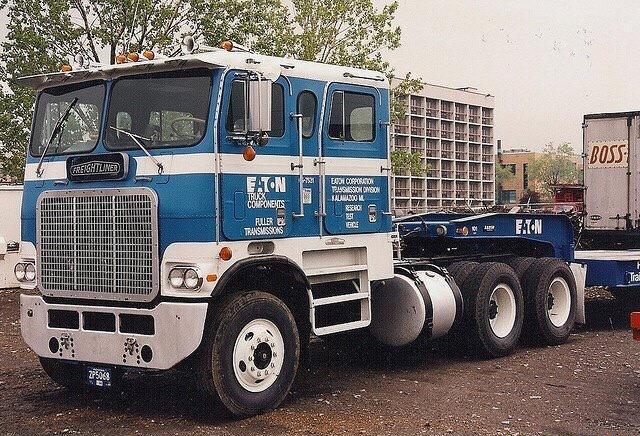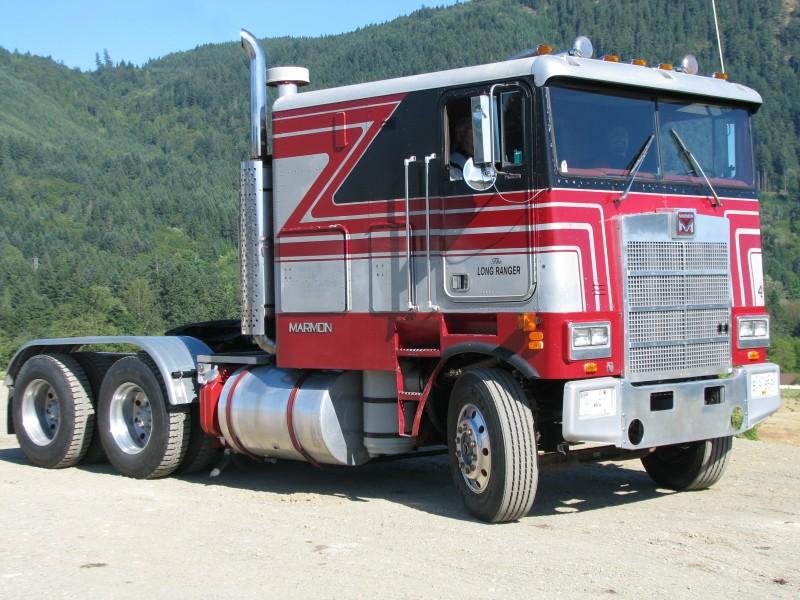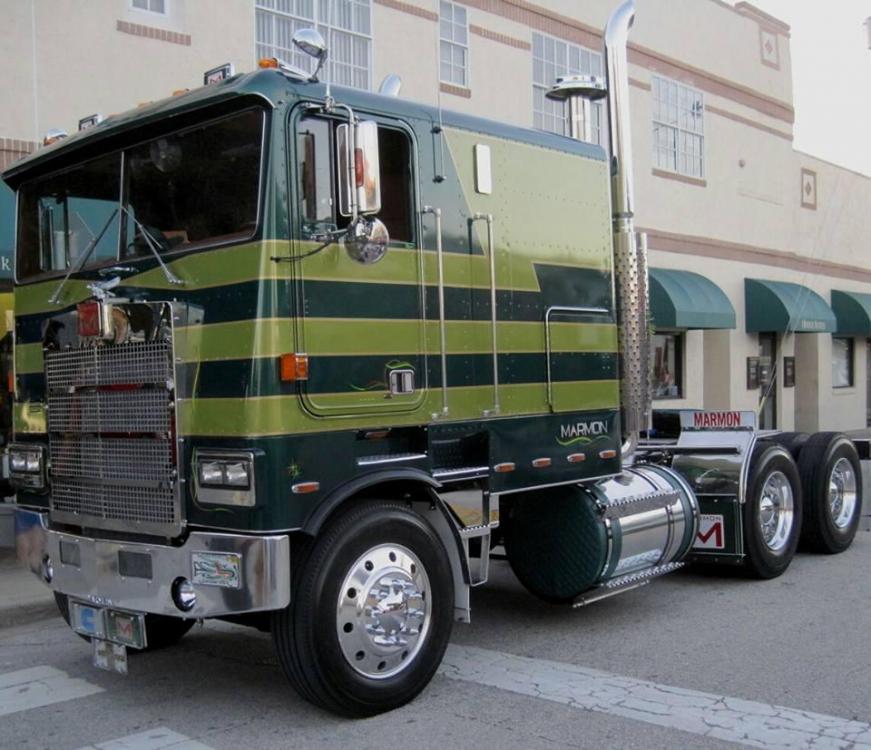
kscarbel2
Moderator-
Posts
18,854 -
Joined
-
Days Won
114
Content Type
Profiles
Forums
Gallery
Events
Blogs
BMT Wiki
Collections
Store
Everything posted by kscarbel2
-
Today's Trucking / July 10, 2018 International’s HX vocational tractor was introduced as a daycab in 2016, but got a sleeper in late 2018. We saw it first at the NACV truck show in Atlanta in last September. Equipment Editor Jim Park took one for a short spin a few weeks later on an off-road track at the company’s proving grounds in New Carlisle, Indiana. .
-
Liebherr introduces 5th generation concrete mixer
kscarbel2 replied to kscarbel2's topic in Trucking News
Sims --> Rite-Way --> Savage --> Mack https://www.bigmacktrucks.com/topic/34458-the-mack-hmm-“front-runner”-front-discharge-mixer-chassis/?tab=comments#comment-229465 -
Same new H62X, Bob. But regarding the grille and headlamp modules, this one has (high level trim package) silver trim around the perimeter absent from the blue truck in the other photo.
-
Henry Kissinger pens ominous warning on dangers of artificial intelligence RT / July 9, 2018 Former US Secretary of State Henry Kissinger has issued a stark warning to humanity: advances in artificial intelligence could lead to a world which humans will no longer be able to understand — and we should start preparing now. What if machines learn to communicate with each other? What if they begin to establish their own objectives? What if they become so intelligent that they are making decisions beyond the capacity of the human mind? Those are some of the questions the 95-year-old Kissinger poses in a piece published by the Atlantic under the apocalyptic headline: ‘How The Enlightenment Ends.’ https://www.theatlantic.com/magazine/archive/2018/06/henry-kissinger-ai-could-mean-the-end-of-human-history/559124/ Kissinger’s interest in artificial intelligence began when he learned about a computer program that had become an expert at Go — a game more complicated than chess. The machine learned to master the game by training itself through practice; it learned from its mistakes, redefined its algorithms as it went along — and became the literal definition of ‘practice makes perfect.’ Into the unknown We are, Kissinger warns, in the midst of a “sweeping technical revolution whose consequences we have failed to fully reckon with and whose culmination may be a world relying on machines powered by data and algorithms and ungoverned by ethical or philosophical norms.” Kissinger uses the example of a self-driving car. Driving a car requires judgements in impossible-to-predict circumstances. What would happen, he asks, if the car found itself having to decide between killing a grandparent or killing a child? Who would it choose, and why? Artificial intelligence goes “far beyond” the kind of automation we are used to, he says, because AI has the ability to “establish its own objectives,” which makes it “inherently unstable.” In other words, through its processes, AI “develops an ability previously thought to be reserved for human beings.” Unintended consequences The typical science-fiction narrative is that robots will develop to the point where they turn on their creators and threaten all of humanity — but, according to Kissinger, while the dangers of AI may be great, the reality of the threat may be a little more benign. It is more likely, he suggests, that the danger will come from AI simply misinterpreting human instructions “due to its inherent lack of context.” One recent example is the case of the AI chatbot called Tay. Instructed to generate friendly conversation in the language patterns of a 19-year-old girl, the machine ended up becoming racist, sexist and giving inflammatory responses. The risk that AI won’t work exactly according to human expectations could, Kissinger says, “cascade into catastrophic departures” from intended outcomes. Too clever for humans The second danger is that AI will simply become too clever for its own good — and ours. In the game Go, the computer was able to make strategically unprecedented moves that humans had not yet conceived. “Are these moves beyond the capacity of the human brain?” Kissinger asks. “Or could humans learn them now that they have been demonstrated by a new master?” The fact is that AI learns much faster than humans. Another recent example was a computer program AlphaZero, which learned to play chess in a style never before seen in chess history. In just a few hours, it reached a level of skill that took humans 1,500 years to reach — after being given only the basic rules of the game. This exceptionally fast learning process means AI will also make more mistakes “faster and of greater magnitude than humans do.” Kissinger notes that AI researchers often suggest that those mistakes can be tempered by including programming for “ethical” and “reasonable” outcomes — but what is ethical and reasonable? Those are things that humans are still fighting over how to define. No way to explain What happens if AI reaches its intended goals but can’t explain its rationale? “Will AI’s decision-making abilities surpass the explanatory powers of human language and reason?” Kissinger asks. He argues that the effects of such a situation on human consciousness would be profound. In fact, he believes it is the most important question about the new world we are facing. “What will become of human consciousness if its own explanatory power is surpassed by AI, and societies are no longer able to interpret the world they inhabit in terms that are meaningful to them?” Legalities and opportunities Outside of philosophical concerns, Kissinger also outlines some legal ones: in this vastly different world, who will be responsible for the actions of AI? How will liability be determined for their mistakes? Can a legal system designed by humans even keep pace with a world run by artificial intelligence capable of outthinking them? But it’s not all doom and gloom. Kissinger admits that AI can bring “extraordinary benefits” to medical science, provision of clean energy and environmental issues, among other areas. Kissinger acknowledges that scientists are more concerned with pushing the limits of discovery than comprehending them or pondering their philosophical ramifications. Governments, too, are more concerned with how AI can be used — in security and intelligence, for example — than examining its results on the human condition. In his final pitch, the senior diplomat implores the US government to make artificial intelligence a major national focus, “above all, from the point of view of relating AI to humanistic traditions.” He argues that a presidential commission of eminent thinkers in the field should be established to help develop a “national vision” for the future. “If we do not start this effort soon,” Kissinger writes, “before long we shall discover that we started too late.”
-
Peterbilt Delivers its First Model 579 UltraLoft Heavy Duty Trucking (HDT) / July 9, 2018 Peterbilt has delivered the keys to the first owner of a new Model 579 UltraLoft after announcing the model earlier this year. Purchased for Oklahoma City-based Freymiller Trucking, the UltraLoft variant of Peterbilt’s flagship Model 579 features a high roof integral cab and sleeper design that prioritizes driver comfort. Designed for a better driver experience, the UltraLoft offers more room and storage than a typical 579 with a larger upper and lower bunk mattress and sleeping area and creature comforts such as a microwave and room for up to a 32-inch flat screen TV. The UltraLoft also features aerodynamic enhancements and reduced weight in order to improve overall efficiency. David Freymiller, president and CEO of Freymiller Trucking noted that his fleet was using the Peterbilt truck as a tool to retain and recruit drivers. “The Model 579 UltraLoft is a game changer as it takes it to a new level,” said Freymiller. “Our drivers are excited to take advantage of the increased space and premium cab design.” .
-
Limit of 300 Gliders Per Small Manufacturer Suspended, EPA Says
kscarbel2 replied to kscarbel2's topic in Trucking News
EPA Will Not Enforce 300-Unit Limit on Glider Kits through 2019 Heavy Duty Trucking (HDT) / July 9, 2018 The Environmental Protection Agency said it will not enforce for 2018 and 2019 a 300-unit production cap put in place on the manufacture of glider kits that do not comply with Phase 2 GHG emission rules. EPA said the action is being taken because it is working to finalize a proposed rule to repeal “certain emission requirements” on glider kits that were imposed under the Phase 2 rules, which were put in place in 2016. News of the enforcement loophole was broken by The New York Times one day after the resignation of EPA Administrator Scott Pruitt on July 5. EPA Press Secretary Molly Block told HDT on July 9 that back in November, the agency proposed to “repeal certain emission requirements for gliders. This proposal also contemplated as alternatives or additional measures an extension of compliance deadlines, and raising the cap on the number of gliders allowed to be built by small manufacturers.” (Per Block, a “small” manufacturer is one defined as such by the Small Business Administration.) In July 2017, after Fitzgerald Glider Kits petitioned EPA to do so, the agency announced it intended to revisit the Phase 2 glider kit provisions. In November, the agency issued its official proposal to entirely repeal emission requirements for glider vehicles, glider engines, and glider kits. The repeal proposal came out only weeks before the 300-unit glider cap was to take effect on Jan. 1 of this year, which is the driving factor behind the newly announced enforcement pause. “The [Phase 2] requirements in question first took effect in January 2017, and limit the number of new glider vehicles that small manufacturers can produce and sell without being subject to additional requirements,” stated Block. “The limit took effect in two stages. In 2017, small manufacturers were limited to the number of gliders they built in their biggest production year between 2010 and 2014. In 2018, small manufacturers are limited to no more than 300 gliders" by the rule. She said EPA took into consideration “public comments received as well as engagement with stakeholders” before determining that “additional evaluation of a number of matters is required before it can take final action on one or more aspects of the [repeal] proposal." However, it should be noted that, per The Washington Post, a Sept. 11 letter to then-EPA chief Pruitt urged him not to revisit the rule, contending that glider kits “should not be used for circumventing purchase of currently certified powertrains.” The letter was signed by executives from Volvo Group North America, Cummins, and Navistar. The companies noted that they were joining the Truck and Engine Manufacturers Association, the American Trucking Associations, and the Truck Rental and Leasing Association in supporting the Phase 2 mandate as written. “Until a final rule can be completed to bring regulatory certainty to glider manufacturers,” Block stated, “the agency is considering interim steps to reduce severe impacts on the industry. First, EPA is considering an extension of the compliance date, which would set a new effective date of Dec. 31, 2019. And, second, the agency is exercising its enforcement discretion in 2018 and 2019 for small manufacturers who limit production to the interim cap provided in 2017.” The decision to not enforce the existing Phase 2 limits on glider kits means that, for at least the next two years, a manufacturer may produce as many gliders as it did during its biggest production year between 2010 and 2014. . -
Limit of 300 Gliders Per Small Manufacturer Suspended, EPA Says
kscarbel2 replied to kscarbel2's topic in Trucking News
EPA gives glider builders a hall pass Trailer-Body Builders / July 7, 2018 Canned EPA Administrator Scott Pruitt on Friday got in a parting shot at Obama-era “regulatory overreach” in his last day in office, ordering the agency not to enforce an annual cap on glider kits. “The Agency is exercising its enforcement discretion in 2018 and 2019,” Molly Block, an agency spokeswoman, said in a statement reported originally by The New York Times. Related: A rough go for gliders in EPA review hearing Gliders, or new chassis into which refurbished older engines without modern emissions control systems can be installed, were deemed to be a substantial loophole in the decade-long EPA effort to greatly reduce emissions from heavy-duty commercial vehicles. Indeed, given the expense and troublesome nature of the mandated emissions controls, production of gliders has soared since 2010, going from going from just a few hundred per year to more than 10,000 in 2015. So, in the Phase 2 Greenhouse Gas Emissions and Fuel Efficiency Standards for Medium- and Heavy-Duty Engines and Vehicles (GHG 2) rule that took effect Jan. 1, 2017, EPA required that engines installed in new glider vehicles meet the emission standards applicable in the year of assembly. A “small business” exception was included in GHG2 to allow glider builders to assemble up to 300 non-compliant units per year through 2020. But last fall, following a lobbying effort and appeal by leading glider builder Fitzgerald Glider Kits, Pruitt determined that that gliders should not be regulated as “new motor vehicles” under the Clean Air Act. “Gliders not only provide a more affordable option for smaller owners and operators, but also serve as a key economic driver to numerous rural communities,” Pruitt said, and EPA proposed to repeal the emission standards and other requirements for glider vehicles. A subsequent public hearing on the matter, however, drew dozens of angry opponents compared to just a couple of supporters. “It’s well-known that gliders are purchased to save money, avoid maintenance costs … and skirt federal excise tax payments,” said Glen Kedzie, American Trucking Associations vice president of energy and environmental affairs council. He noted that ATA member fleets have paid $31,000 more on average per new truck since 2004 to comply with new emissions rules. And Susan Alt, senior vice president of public affairs, Volvo Group North America, cited EPA’s own testing which found that glider vehicles emit 43 times more NOx and 55 times more soot than today’s low-emission diesels. EPA estimates that gliders make up about 5% of the entire Class 8 market, but contribute about one-third of all NOx and particulates from the sector. “The current annual impact of glider emissions already grossly outweighs that of the VW diesel engine violations in the U.S. at their peak,” Alt said. “A repeal of the Phase 2 glider provisions makes a mockery of the massive investments we’ve made to develop low-emission compliant technology.” Rep. Jamie Raskin of Maryland said he was “baffled and confounded” as to why EPA would consider a repeal. He noted that Fitzgerald had failed to secure legislative relief, so the company’s owners then met directly with Pruitt. According to Raskin, Fitzgerald’s petition included new information on glider vehicle emissions which purported to show that gliders were less polluting than non-glider vehicles. But that “independent” study was bought and paid for by none other than Fitzgerald. “It is important to note that the study, run by Tennessee Tech University, has been criticized by experts for its poor and shoddy quality and has provoked serious ethical questions about the university’s academic independence and its cozy relationship with Fitzgerald,” he said. On the other side, glider builder and trucker Farrell “Dale” Clark Jr., president of D & B Trucks, said he fully supported the proposal, and he referenced the Fitzgerald-funded study. Clark stressed that the only new parts in a glider kit are the cab and the hood; the remaining parts of the truck are all used parts. He also noted an environmental benefit to the pro-glider case: “We really should be thanking our glider builders. We should be encouraging every trucker in this country to use a glider, or should I say a ‘recycled truck,’” Clark said. “This is exactly what we do in our business. We recycle old trucks, not only do we create hundreds of jobs, we save our trucking industry thousands of dollars.” Tennessee Tech later informed EPA that the agency should not use the university's study on glider kits in developing federal emissions regulations, and that the school was pursuing a peer review of the report and investigating claims of research misconduct. -
Limit of 300 Gliders Per Small Manufacturer Suspended, EPA Says
kscarbel2 replied to kscarbel2's topic in Trucking News
Report: EPA won’t enforce glider emissions limits until end of next year James Jaillet, Commercial Carrier Journal (CCJ) / July 9, 2018 The U.S. EPA has said it will not enforce Obama-era emissions restrictions placed on glider kit manufacturers at least through the end of next year, giving glider kit builders like Fitzgerald Glider Kits a substantial victory in their fight against the regulations.Manufacturers like Fitzgerald will be limited in 2018 and 2019 to producing the number of vehicles they produced in 2017, which is well above the 300-a-year cap. Starting this year, glider kit manufacturers were limited to building 300 trucks a year that did not comply with the Phase 2 emissions regulations, finalized by the EPA in 2016. The EPA has a rule in the works to permanently repeal the glider-specific portions of the Phase 2 emissions standards, but the rule has not yet been made final, leaving glider kit builders caught in a regulatory limbo. The EPA proposed the rule in November 2017, just over a month before the 300-truck cap was slated to take effect, leaving the agency little time to finalize the repeal before Phase 2’s January 1 effective date. However, an EPA spokesperson has told CCJ the agency is “exercising its enforcement discretion” this year and next year and will not hold glider kit makers to the 300-a-year cap. Fitzgerald Glider Kits, the country’s largest builder of gliders, and others have fought the regs since they were proposed in 2015, arguing they would kill the glider kit industry. Demand for glider trucks, which are new truck bodies equipped with older, remanufactured engines and transmissions, has soared over the past decade, since they’re equipped with engines that do not use exhaust gas recirculation and do not require exhaust after-treatment. They’re also cheaper than new trucks. The 300-truck cap was meant to offer fleets and owner-operators an exemption from the regs, so that truck owners who wanted to equip glider kits with older engines could do so. But for builders who assemble and sell thousands of trucks a year, like Fitzgerald, the regs would have caused them to dramatically alter their businesses to stay alive. Receptive to these concerns, EPA under President Trump sought to overturn portions of the Phase 2 regulations that applied to glider kit makers. The move has been fought by major truck OEs like Volvo, Cummins and Daimler. -
Thor Trucks to Launch New Entry in Battery-Electric Class 8 Market Transport Topics / July 9, 2018 Thor Trucks Inc., a startup not quite 2 years old, will manufacture electric-battery Class 8 trucks beginning next year, according to the Los Angeles-based company. At the same time, California has a new multimillion-dollar funding stream to proliferate such vehicles and encourage additional manufacturers to make them. Thor intends to market in 2019 the ET-1, a battery-electric Class 8 day cab that will have a 100-mile range and cost $150,000. Through savings — and not public subsidies — the truck will pay for itself in three to four years, according to the company, which also is exploring opportunities in China and Europe. Another Class 8 costing $250,000 with a 300-mile range is planned as part of Thor’s strategy of relying on contract manufacturing and alliances with existing suppliers instead of a factory of its own and vertical integration of key components. “We have established manufacturing agreements with two different manufacturing facilities in the Midwest, and that’s where we will be doing our series production,” Thor CEO and co-founder Dakota Semler said during a conference call hosted by investment firm Stifel, Nicolaus & Co. One of the agreements has been solidified; the other is in process, Semler said June 27 during the call. “And beyond that, there is obviously some engineering process that has to be done to integrate the trucks into those production lines,” he said. “But 2019 is very realistic to achieve our goals for production.” Thor is placing the majority of its focus on drayage, food and beverage delivery, and less-than-truckload fleets, Semler told Transport Topics. Meanwhile, Thor and other new manufacturers of alternative-power trucks stand to benefit from a portion of California’s $423 million share of the Volkswagen Environmental Mitigation Trust. The trust was established after VW’s use of software designed to cheat during emissions tests in 2.0- and 3.0-liter diesel vehicles, and funding is available to states where those cars ran. The California Air Resources Board announced it intends to use $90 million of California’s overall share to replace eligible Class 8 freight trucks and port drayage trucks with new zero-emission technologies. “While zero-emission Class 8 trucks are commercially available today, manufacturer diversity is limited. The focus of this funding is to support the market introduction of zero-emission trucks from a wide range of manufacturers that will be deploying trucks in the next five years,” according to the state’s plan. One industry executive said vast changes in trucking were at hand. “There are a lot of ideas coming out now that can help simplify the complexity in the marketplace,” said Gerry Mead, executive director of innovations for Phillips Industries. “When you look at electric trucks in general and you look at the operational cost for a trucking company, maintenance is a very large part of that, and you can lump in diesel fuel with that,” Mead said. “So if you have the ability to take a really large cost item and drastically cut it out of your [operation], obviously that improves your bottom line.” A Thor truck’s battery design is different in its layout and cooling process compared with most electric batteries, Thor co-founder and Chief Operating Officer Giordano Sordoni told TT. “These key engineering differences mean that Thor’s battery is one of the most energy-dense on the market, so much so that it is competitive on a shorthaul basis with diesel engines in terms of energy efficiency and cost,” Sordoni said. Thor is using cylindrical-shaped nickel, cobalt and manganese (NCM) batteries whose cost already is below $400 per kilowatt hour, Semler said. “The price tier that we have to get below, and we have a clear path to that, is $200 a kWh. The reality is there are very few people selling battery packs at that $200 kWh price range. So we have basically focused on trying to achieve that so that we could achieve a market-viable truck. And we expect to hit that in the early part of 2020.” Thor will warrant that its batteries operate for 2000 cycles, Semler said. “Two thousand cycles is just the period in which we warrant the pack to retain 80% of its original rated capacity.” Some fleets have agreed to purchase demonstration vehicles to use at Southern California ports. Drayage occurs in an area that is “pretty seeded with utility infrastructure so we don’t have too many issues there deploying charging systems,” Semler said. If needed, Thor will consult with fleets on the necessary charging infrastructure, which can run from $25,000 to $100,000, he said. “We all aim to be aggressive in this space in order to compete with diesel,” Semler said. All the traditional heavy-duty truck makers that sell in North America also are developing electrified vehicles in existing models. Plus Tesla Inc., and Nikola Motor Co. are readying new trucks for sale and tests, respectively, in 2019. Toyota Motor North America has a pilot project underway using a hydrogen-electric Class 8 truck at the Southern California ports. .
-
Transport Topics / July 9, 2018 The U.S. Environmental Protection Agency (EPA) has suspended through the end of 2019 a cap on the number of glider kits that a single builder may produce, the agency told Transport Topics July 9. The move lifts the current annual cap of 300 glider kits per manufacturer, a limit instituted during the Obama administration which EPA has proposed to repeal. After reviewing comments on that proposal submitted by stakeholders, the agency determined additional evaluation is needed before a final decision is made, said Molly Block, an EPA spokeswoman. She added that EPA is exercising its enforcement discretion this year and for 2019 as it relates to manufacturers of glider kits. “Until a final rule can be completed to bring regulatory certainty to glider manufacturers, the agency is considering interim steps to reduce severe impacts on the industry,” Block said. She noted that one option the agency is considering is extending to Dec. 31, 2019 the compliance date for the 300-unit limit. In November 2017, the agency proposed to repeal certain emissions requirements for gliders. As Block put it, the repeal proposal “contemplated as alternatives or additional measures an extension of compliance deadlines, and raising the cap on the number of gliders allowed to be built by small manufacturers.” The agency’s move, first published July 6 in The New York Times, essentially would allow glider companies to sell more than 300 vehicles annually while the agency crafts its glider rule repeal. The agency’s former administrator, Scott Pruitt, announced his resignation on July 5. Deputy administrator Andrew Wheeler took on the role of acting chief. At the start of 2017, small manufacturers were limited to the number of gliders they built in their biggest production year between 2010 and 2014. In 2018, those manufacturers were limited to no more than 300 gliders. EPA’s 2016 Phase 2 heavy-truck greenhouse gas emissions rule includes the limits to the number of gliders with engines that predate current emissions regulations that can be built by a company annually. The rule also requires certain gliders to be certified as emissions-compliant for the model year they are built. .
-
- 1 reply
-
- 1
-

-
-
The Powerliner......one of my favorite COEs. And again, in a certain sense, it doesn't look particularly old. .
-
I hope that you're able to store your truck indoors Paul.
-
-
I have to say, I rarely see any L8000 and L9000 trucks on the road today. Most were owned by the fleets (alike GMC Brigadiers), who purged them many years ago during their routine equipment upgrades. An evolved-forward HN80 could stand with any North American truck on the market today. Don't you agree Bob?
-
Liebherr introduces 5th generation concrete mixer
kscarbel2 replied to kscarbel2's topic in Trucking News
Liebherr, always an industry leader, offers a full range of front-discharge mixers. https://www.liebherr.com/en/usa/products/construction-machines/concrete-technology/conveyor-belts/conveyor-belts.html . -
When you called the Mack brand sales person who sold you the truck, or any Mack brand distributor, what was the response?
-
Ford never sold the Louisville plant.....they re-purposed it. Sterling production took place in Canada..............http://www.fleetowner.com/mag/fleet_sterling_trucks_launched
-
Bob, they would likely produce a narrower version of the H62X cab for a conventional variant. For example, the narrow width Freightliner Century Class, Columbia and Coronado use the same cab platform as the wider full-width Argosy. The cab on the conventionals is 305mm (12 inches) narrower.
-
Years ago, Marmon wanted me to be a distributor and showed me an interesting promotional film including their plant. I wish that I had a copy to share with everyone now.
-
And yet, Cummins, Dana, Paccar, Tenneco and WABCO have been posting new 52-week lows almost daily.
-
Jason Cannon, Commercial Carrier Journal (CCJ) / July 5, 2018 North American Class 8 truck orders topped 41,800 units last month according to FTR, 140 percent above last year and the highest June order total on record. Heavy truck orders have exceeded 40,000 units in four of the six months this year. The rate at which fleets are ordering trucks has put a strain on the supply chain, and FTR Vice President of Commercial Vehicles Don Ake says OEMs have struggled to keep production on pace with demand. “There is an enormous demand for trucks due to burgeoning freight growth and extremely tight industry capacity,” he says. “However, supply is severely constrained because OEM suppliers cannot provide the needed parts and components required to build more trucks fast enough. This bottleneck is causing fleets to get more orders in the backlog in hopes of getting more trucks as soon as they are available.” The backlogs are being moved out further, which is pushing fleets to get orders in sooner rather than later so they can find a build slot, Ake says. “Fleets are desperate for more equipment, but trucks are in short supply due to the supplier constraints. This is creating a surge in orders as fleets react to this unusual situation,” he adds. “If OEMs were producing at capacity, the truck build this year could have been as high as 360,000 units.” North American Class 8 orders for the past twelve months have now totaled 411,000 units, which Ake notes indicates “there are some excess orders in the backlog.”
BigMackTrucks.com
BigMackTrucks.com is a support forum for antique, classic and modern Mack Trucks! The forum is owned and maintained by Watt's Truck Center, Inc. an independent, full service Mack dealer. The forums are not affiliated with Mack Trucks, Inc.
Our Vendors and Advertisers
Thank you for your support!


